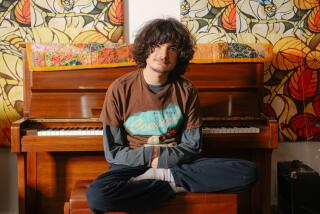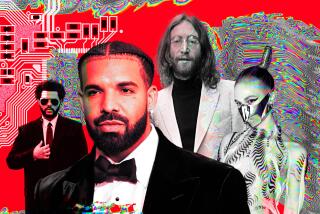Tuning Up Brains : Early Musical Training May Enhance a Child’s Mental Ability
- Share via
ANAHEIM — Early musical training, even as early as age 3, may enhance a child’s overall mental ability, UC Irvine brain researchers said Sunday.
It has long been known that infants recognize and respond to music and that appreciation for works by composers such as Bach and Mozart transcends generations, geography and culture. The reason, the team of UCI scientists believe, is that humans are born with certain brain cells that respond to musical sounds.
These neurons fire in patterns that can be expanded as a sort of “pre-language” to perform ever-more complex interactions--even before the brain has developed verbal language skills, UCI physicist Gordon Shaw said. And this ability may well bolster higher-level thinking skills, he told members of the National Assn. of Music Merchants at a conference at the Anaheim Hilton.
“We don’t believe that by taking violin lessons you’re going to become Albert Einstein,” said Shaw, pointing to a well-known photograph of the famed genius playing his violin. “On the other hand, we think this ability is going to be a very useful tool in any kind of higher brain activity. So (musical training) amounts to exercising, not muscles, but brain cells.”
To prove the thesis, he and fellow researchers plan to test preschool music students from local conservatories and track them over time to see how they develop in other areas.
“We want to use music as a window on the brain,” said Shaw, who is working with fellow UCI scientists Norman Weinberger, a psychobiologist; Xiaodan Leng, a physicist, and musician Eric Wright of the Irvine Conservatory of Music. “Maybe they’re going to do better at putting puzzles together after musical training.”
The music merchants association, which goes by the acronym NAMM, has donated $25,000 toward the research project. With another $25,000 provided recently by the Ralph and Leona Gerard Foundation of Irvine, Shaw said he hopes to hire a postdoctoral researcher in child development by this summer to begin testing at least half a dozen youngsters.
On Sunday, at least, he and his collaborators at UCI’s Center for the Neurobiology of Learning and Memory, were preaching to the choir.
“This research could have a profound effect on our industry and on music training in general,” predicted NAMM president Larry R. Linkin.
But NAMM marketing director Karl Bruhn, a former professional musician, insisted that altruism, not the desire to ensure future spending on music instruments and training, prompted NAMM’s support for the research.
“We, as musicians, believe passionately and deeply in the importance of music to the educational development of our children,” Bruhn said.
Experts have long seen similarities between music, mathematics and chess. All involve the ability to detect abstract relationships. Skill in any of these areas often corresponds to better-than-average ability in the others. For example, some child prodigies in mathematics, often show talent in chess or music as well, Shaw said.
The link, the researchers believe, is in the dynamic development of certain brain cell groupings that respond to patterns, whether in numbers, in musical notes or moves on a chessboard. They believe that the brain is organized into columns of neurons, which Shaw has named “trions,” and these columns communicate with each other by firing bursts of electrical energy.
In infants, the number of these neural connections is very small. As a young child develops, these links grow exponentially. Shaw believes that they increase in response to learned experiences. “With professional musicians, even more of the brain is used,” he said.
Weinberger also noted that music is processed in a different area of the brain than is used for language skills. In right-handed people, for example, he said the right hemisphere of the brain is the seat of musical information, while language functions take place in the left hemisphere.
Researchers still don’t have concrete evidence to prove how the information is communicated within the brain. While there exist many sophisticated tests to study a living human brain, none can yet explore neuron interaction at the detailed cellular level.
Instead, Shaw and his colleagues developed a computer model of these trions. To explore the effect of music on them, he and Leng used keyboard synthesizers to assign musical tones to trions. When played back, Leng said the music of the trions resembles tunes produced by humans. Depending on the notes and intervals programmed, the so-called “brain music” can have the sound of a waltz, a minuet or pop music, she said.
Weinberger said his own research on how learning alters the mind’s ability to process and store information shows that cells within the brain’s auditory cortex are a dynamic, evolving system.
“We discovered that auditory cells get tuned or retuned by experience, by what is important,” he said. “That’s a very different picture of a sensory system. Most people would think that the auditory system is a fancy telephone system. In fact, it is dynamic . . . and what is perceived as musical sounds (is) actually learned over time, from infancy.”
Weinberger also told NAMM members that he and Shaw are less than a year away from offering a computerized database of key research on music and the brain dating back to 1880. The UCI-based databank, called the Music Brain Information Center and funded with a separate $25,000 grant from NAMM, should be accessible by December to any researcher around the world with a telephone and a computer modem.
“We’ve got over 2,500 selected references in the database now,” he said. “We hope by the end of the year to have about 7,000 entries.”
The hope, he and Shaw said, is to help stimulate communication and research among neuroscientists, psychologists, music theorists, pediatricians and others.
But several NAMM members hope that the databank and the team’s research can do something more--provide vital ammunition to persuade this nation’s educators and governmental leaders to spend money on music education.
“We live in a world of words, and the only way we’ll have the words to defend the arts--music in particular--from the kinds of budget cuts being suggested by conscientious people who have other priorities than arts and music, is through the insights which (the database) and Shaw’s research can provide,” Ralph Rintzler, a former secretary of the Smithsonian Institution, said after hearing the scientists’ presentation.
He said a recent report citing the dire need for more math and science training in the nation’s schools doesn’t go far enough.
Music “is unquestionably as important to educational development as math and science,” said Rintzler, a music specialist at the Smithsonian who helped produce the 1988 Columbia Records all-star album, “Folkways: A Vision Shared--A Tribute to Woody Guthrie.”
“If indeed music is a pre-language stimulus to the brain, and relates to existing patterns that cross cultural and geographic lines, then musical training must have something to do with the development and the exercise of the brain itself,” Rintzler said.
Pending their results, Shaw had this advice for parents: “Give your kids an enriched environment early on. Whether our ideas are right or not, what we know already about music and its effect on the brain stands for itself.”
Brain Networking
These examples illustrate how the brain develops neurological links that transmit and store information as a child grows. Infants have a relatively small network in the brain. Within the first two years of life, the neural connections increase exponentially. Researchers at UCI’s Center for the Neurobiology of Learning and Memory believe these connections increase in response to learned experiences.
Source: UC Irvine






